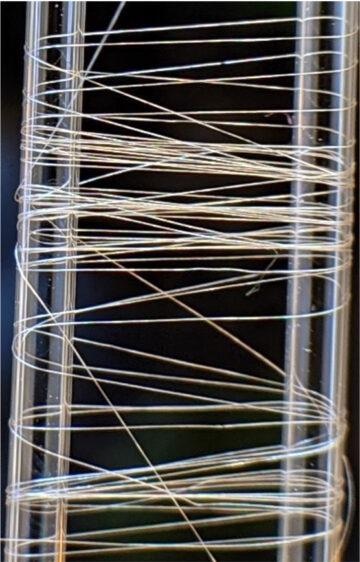Spider silk is considered one of the strongest and toughest materials found on Earth. Engineers from Washington University in St. Louis have now developed amyloid-silk hybrid proteins and generated them in engineered bacteria.
 Spun polymeric amyloid fiber. Image Credit: Jingyao Li.
Spun polymeric amyloid fiber. Image Credit: Jingyao Li.
The yielded fibers are tougher and stronger compared to a few of the natural spider silks. The study was published in the journal ACS Nano.
In detail, the artificial silk known as “polymeric amyloid” fiber was produced by making use of bacteria in the laboratory. The bacteria were genetically engineered in the laboratory of Fuzhong Zhang, a professor in the Department of Energy, Environmental & Chemical Engineering in the McKelvey School of Engineering.
Zhang has previous experience working with spider silk. In 2018, a bacteria was engineered in his laboratory to produce recombinant spider silk that has mechanical properties very close to its natural counterparts.
After our previous work, I wondered if we could create something better than spider silk using our synthetic biology platform.
Fuzhong Zhang, Professor, Department of Energy, Environmental and Chemical Engineering, McKelvey School of Engineering, Washington University in St. Louis
Jingyao Li, a PhD student in Zhang’s lab, was also a part of the research team. The team altered the amino acid sequence of spider silk proteins for developing new properties while retaining some of the appealing features of spider silk.
An issue that is closely related to the recombinant spider silk fiber is the demand to produce β-nanocrystals, which is the main component of natural spider silk that provides strength to the material. However, this needs to be done without making notable modifications to the spider silk sequence.
Spiders have figured out how to spin fibers with a desirable amount of nanocrystals. But when humans use artificial spinning processes, the amount of nanocrystals in a synthetic silk fiber is often lower than its natural counterpart.
Fuzhong Zhang, Professor, Department of Energy, Environmental and Chemical Engineering, McKelvey School of Engineering, Washington University in St. Louis
To resolve this issue, the researchers redesigned the silk sequence by adding an amyloid sequence with a high tendency to develop β-nanocrystals. Different polymeric amyloid proteins were produced with the help of three well-investigated amyloid sequences as representatives. The end proteins have a low repetitive amino acid sequence compared to the spider silk, thereby enabling easier production by engineered bacteria.
Finally, the bacteria generated hybrid polymeric amyloid protein with 128 repeating units. The recombinant expression of spider silk protein with similar repeating units tends to be challenging.
The length of the protein governs the strength and toughness of the fiber. The 128-repeat proteins yielded a fiber with gigapascal strength (a measure of how much force is required to break a fiber of fixed diameter), possessing strength greater than that of common steel.
The toughness of the fiber (a measure of how much energy is required to break a fiber) is greater compared to Kevlar and all previous recombinant silk fibers. The achieved strength and toughness are noted to be greater than that of the natural spider silk fibers.
In association with Young-Shin Jun, professor in the Department of Energy, Environmental & Chemical Engineering, and her PhD student Yaguang Zhu, researchers ascertained that the high mechanical properties of the polymeric amyloid fibers are a result of the improved quantity of β-nanocrystals.
The newly developed proteins and the obtained high-performance synthetic fibers in Zhang’s laboratory still have the potential for improvisation.
“This demonstrates that we can engineer biology to produce materials that beat the best material in nature,” added Zhang.
The researchers have just discovered three of the thousands of amyloid sequences with the ability to improve the features of natural spider silk.
There seem to be unlimited possibilities in engineering high-performance materials using our platform. It’s likely that you can use other sequences, put them into our design and also get a performance-enhanced fiber.
Jingyao Li, PhD Student, Department of Energy, Environmental and Chemical Engineering, Washington University in St. Louis.
Journal Reference:
Li, J., et al. (2021) Microbially Synthesized Polymeric Amyloid Fiber Promotes β-Nanocrystal Formation and Displays Gigapascal Tensile Strength. ACS Nano. doi.org/10.1021/acsnano.1c02944.